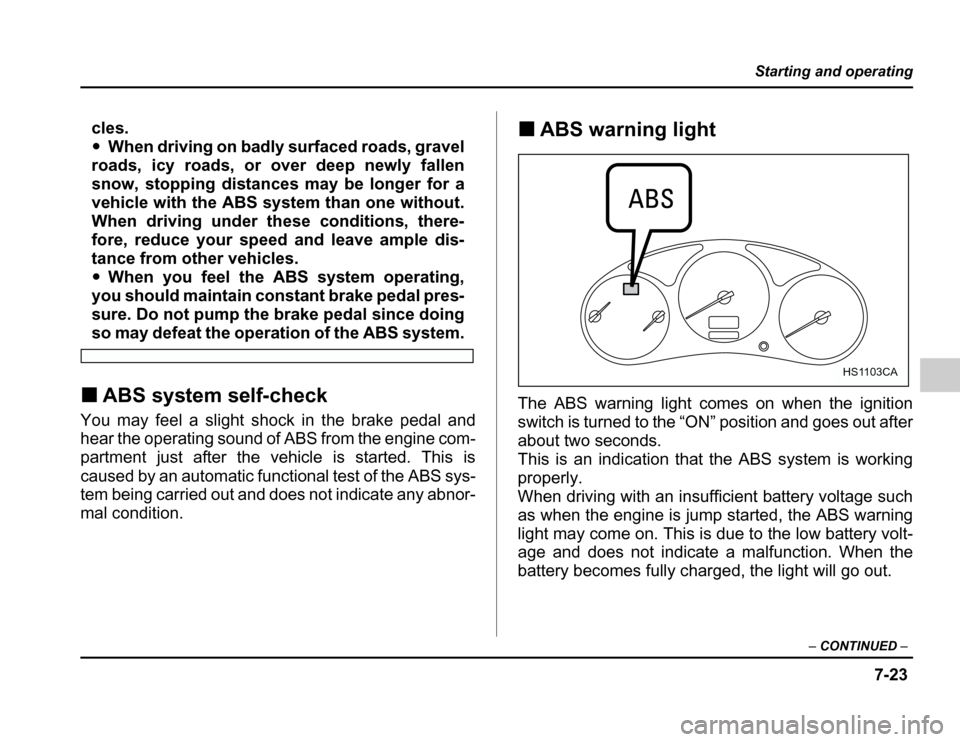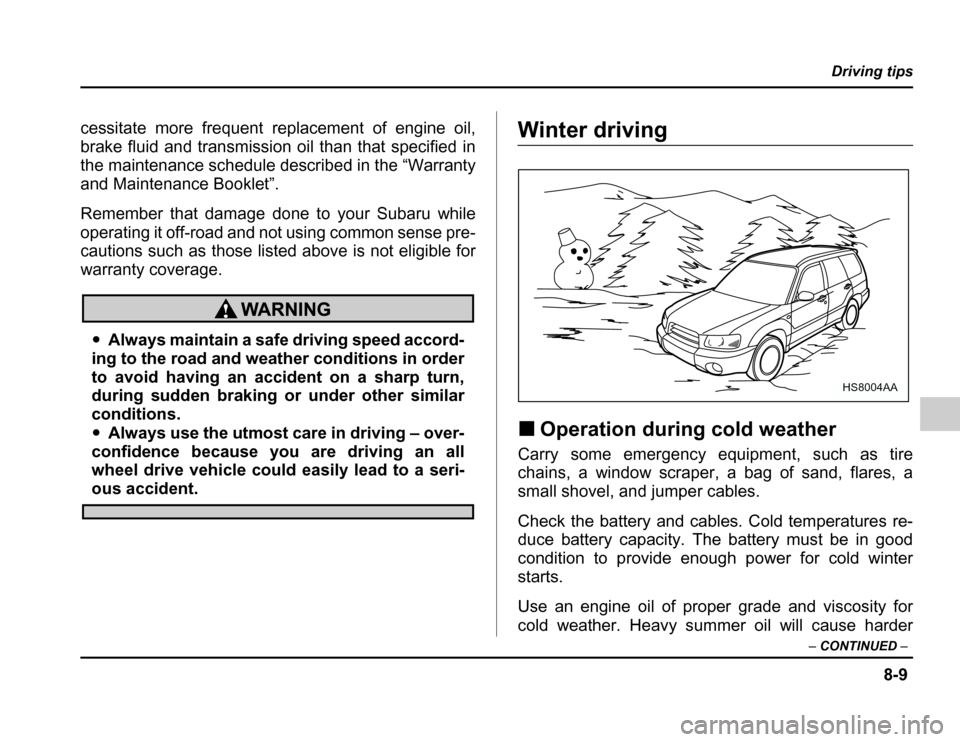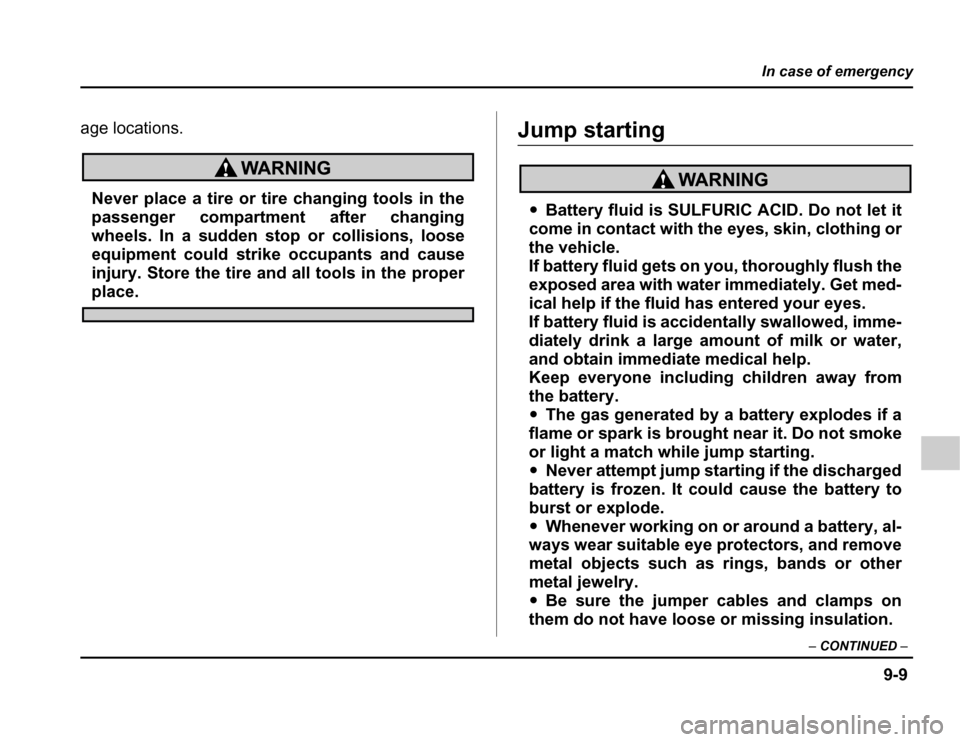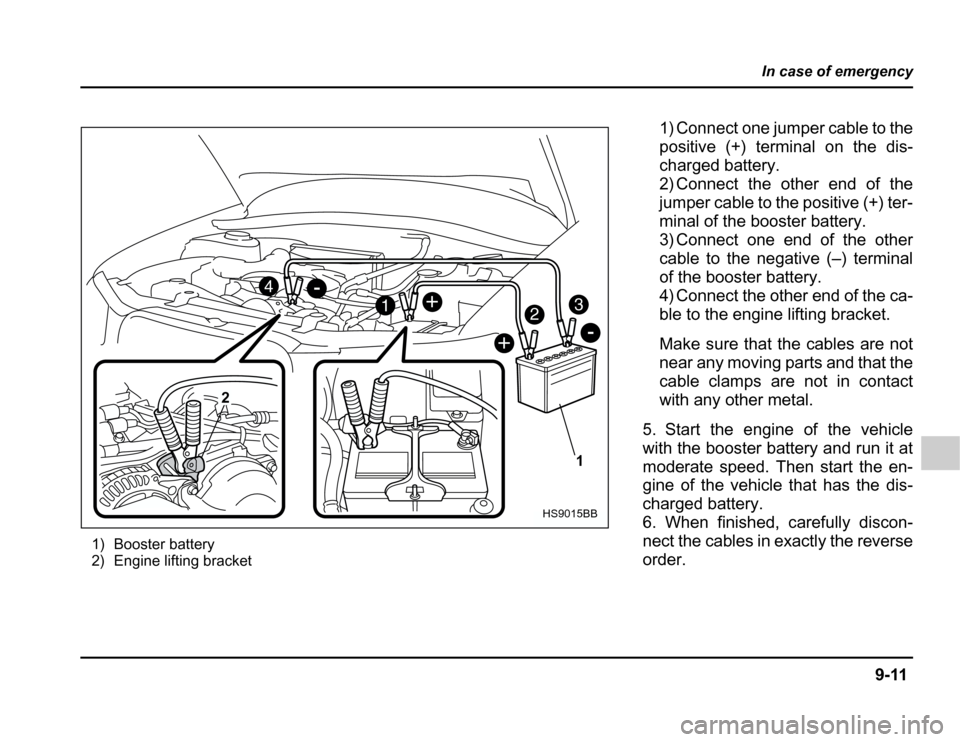2003 SUBARU FORESTER jump start
[x] Cancel search: jump startPage 132 of 420

3-13
Instruments and controls
–CONTINUED –
further details of the EBD system fault warning, refer
to “Brake system warning light”.
NOTE
If the warning light behavior is as shown below,
the ABS system may be considered normal.�The warning light comes on right after the en-
gine is started but goes out immediately, remain-
ing off.� The warning light remains on after the engine
has been started, but it goes out when the vehicle
speed reaches about 8 mph (12 km/h).� The warning light comes on during driving, but
it goes out immediately and remains off.
When driving with an insufficient battery voltage such
as when the engine is jump started, the ABS warning
light may come on. This is due to the low battery volt-
age and does not indicate a malfunction. When the
battery becomes fully charged, the light will go out. � Brake system warning light
�Driving with the brake system warning light
on is dangerous. This indicates your brake sys- tem may not be working properly. If the light re-
mains on, have the brakes inspected by a
SUBARU dealer immediately. �
If at all in doubt about whether the brakes are
operating properly, do not drive the vehicle.
Have your vehicle towed to the nearest
SUBARU dealer for repair.
This light has the following three functions: � Parking brake warning
The light comes on with the parking brake applied
while the ignition switch is in the “ON” position. It goes
out when the parking brake is fully released. � Brake fluid level warning
This light comes on when the brake fluid level has
dropped to near the “MIN” level of the brake fluid res-
ervoir with the ignition switch in the “ON” position and
with the parking brake fully released.
If the brake system warning light should come on while
driving (with the parking brake fully released and with
the ignition switch positioned in “ON”), it could be an
indication of leaking of brake fluid or worn brake pads.
If this occurs, immediately stop the vehicle at the near-
est safe place and check the brake fluid level. If the flu-
(U.S.) (Canada)
Page 247 of 420

7-14
Starting and operating
Automatic transmission
The automatic transmission is electronically controlled
with 4-forward speeds and 1-reverse speed.
NOTE
Immediately after a disconnected battery is recon-
nected or ATF (automatic transmission fluid) is re-
placed, you may feel that the automatic
transmission operation is somewhat unusual.
This results from erasure or invalidation of data
the on-board computer has collected and stored in
memory to allow the transmission to shift at the
most appropriate times for the current condition
of your vehicle. Optimized shifting will be restored
as the vehicle continues to be driven for a while.
Do not shift from the “P” or “N” position into
the “D”, “3”, “2”, “1” or “R” position while de-
pressing the accelerator pedal. This may cause
the vehicle to jump forward or backward.
�
Shift into the “P” or “R” position only after the vehicle is completely stopped. Shifting
while the vehicle is moving may cause damage
to the transmission. �
Do not race the engine for more than five sec-
onds in any position except the “N” or “P” po-
sition when the brake is set or the tires are on
blocks. This may cause the automatic transmis-
sionfluidtooverheat.� Avoid shifting from one of the forward driving
positions into the “R” position or vice versa un-
til the vehicle has completely stopped. Such
shifting may cause damage to the transmis-
sion.
Page 256 of 420

7-23
Starting and operating
–CONTINUED –
cles. �When driving on badly surfaced roads, gravel
roads, icy roads, or over deep newly fallen
snow, stopping distances may be longer for a
vehicle with the ABS system than one without.
When driving under these conditions, there-
fore, reduce your speed and leave ample dis-
tance from other vehicles.� When you feel the ABS system operating,
you should maintain constant brake pedal pres-
sure. Do not pump the brake pedal since doing
so may defeat the operation of the ABS system.
� ABS system self-check
You may feel a slight shock in the brake pedal and
hear the operating sound of ABS from the engine com-
partment just after the vehicle is started. This is
caused by an automatic functional test of the ABS sys-
tem being carried out and does not indicate any abnor-
mal condition. �
ABS warning light
The ABS warning light comes on when the ignition
switch is turned to the “ON” position and goes out after
about two seconds.
This is an indication that the ABS system is working
properly.
When driving with an insufficient battery voltage such
as when the engine is jump started, the ABS warning
light may come on. This is due to the low battery volt-
age and does not indicate a malfunction. When the
battery becomes fully charged, the light will go out.
HS1103CA
Page 278 of 420

8-9
Driving tips
– CONTINUED –
cessitate more frequent replacement of engine oil,
brake fluid and transmission oil than that specified in
the maintenance schedule described in the “Warranty
and Maintenance Booklet”.
Remember that damage done to your Subaru while
operating it off-road and not using common sense pre-
cautions such as those listed above is not eligible for
warranty coverage.
�Always maintain a safe driving speed accord-
ing to the road and weather conditions in order
to avoid having an accident on a sharp turn,
during sudden braking or under other similar
conditions.� Always use the utmost care in driving – over-
confidence because you are driving an all
wheel drive vehicle could easily lead to a seri-
ous accident.
Winter driving � Operation during cold weather
Carry some emergency equipment, such as tire
chains, a window scraper, a bag of sand, flares, a
small shovel, and jumper cables.
Check the battery and cables. Cold temperatures re-
duce battery capacity. The battery must be in good
condition to provide enough power for cold winterstarts.
Use an engine oil of proper grade and viscosity for
cold weather. Heavy summer oil will cause harder
HS8004AA
Page 306 of 420

9-1
9
In case of emergency
If you park your vehicle in case of an
emergency .................................................... 9-2
Flat tires ........................................................ 9-3 Changing a flat tire ......................................... 9-3
Jump starting ............................................... 9-9 How to jump start ........................................... 9-10
Engine overheating ...................................... 9-12 If steam is coming from the engine
compartment ................................................... 9-12
If no steam is coming from the engine
compartment ................................................... 9-12
Towing .......................................................... 9-13 Towing and tie-down hooks .......................... 9-13
Using a flat-bed truck ..................................... 9-15
Towing with all wheels on the ground .......... 9-15
Rear gate — if the rear gate cannot be
unlocked ....................................................... 9-17
Moonroof – if the moonroof cannot be
closed ............................................................ 9-18
Maintenance tools ........................................ 9-19 Jack and jack handle ...................................... 9-19
Page 314 of 420

9-9
In case of emergency
–CONTINUED –
age locations.
Never place a tire or tire changing tools in the
passenger compartment after changing
wheels. In a sudden stop or collisions, loose
equipment could strike occupants and cause
injury. Store the tire and all tools in the proper
place.
Jump starting
�Battery fluid is SULFURIC ACID. Do not let it
come in contact with the eyes, skin, clothing or
the vehicle.
If battery fluid gets on you, thoroughly flush the
exposed area with water immediately. Get med-
ical help if the fluid has entered your eyes.
If battery fluid is accidentally swallowed, imme-
diately drink a large amount of milk or water,
and obtain immediate medical help.
Keep everyone including children away from
the battery.� The gas generated by a battery explodes if a
flame or spark is brought near it. Do not smoke
or light a match while jump starting.� Never attempt jump starting if the discharged
battery is frozen. It could cause the battery to
burst or explode.� Whenever working on or around a battery, al-
ways wear suitable eye protectors, and remove
metal objects such as rings, bands or other
metal jewelry. � Be sure the jumper cables and clamps on
them do not have loose or missing insulation.
Page 315 of 420

9-10
In case of emergency
Do not jump start unless cables in suitable con-
dition are available.�
A running engine can be dangerous. Keep
your fingers, hands, clothing, hair and tools
away from the cooling fan, belts and any other
moving engine parts. Removing rings, watches
andtiesisadvisable.
When your vehicle does not start due to a run down
(discharged) battery, the vehicle may be jump started
by connecting your battery to another battery (called
the booster battery) with jumper cables.
Jump starting is dangerous if it done incorrectly. If you
are unsure about the proper procedure for jump start-
ing, consult a competent mechanic. � Howtojumpstart
1. Make sure the booster battery is 12 volts and the
negative terminal is grounded.
2. If the booster battery is in another vehicle, do not let
the two vehicles touch.
3. Turn off all unnecessary lights and accessories.
4. Connect the jumper cables exactly in the sequence
illustrated.
Page 316 of 420

9-11
In case of emergency
–CONTINUED –
1) Booster battery
2) Engine lifting bracket
23
1
4
+
-
-
+
1
2
HS9015BB
1) Connect one jumper cable to the
positive (+) terminal on the dis-
charged battery.
2) Connect the other end of the
jumper cable to the positive (+) ter-
minal of the booster battery.
3) Connect one end of the other
cable to the negative (–) terminal
of the booster battery.
4) Connect the other end of the ca-
ble to the engine lifting bracket.
Make sure that the cables are not
near any moving parts and that the
cable clamps are not in contact
with any other metal.
5. Start the engine of the vehicle
with the booster battery and run it at
moderate speed. Then start the en-
gine of the vehicle that has the dis-
charged battery.
6. When finished, carefully discon-
nect the cables in exactly the reverse order.